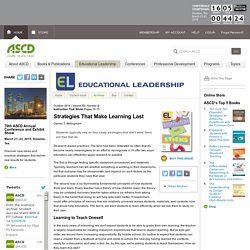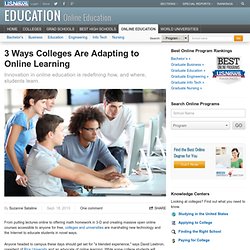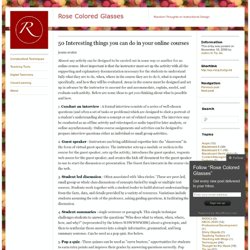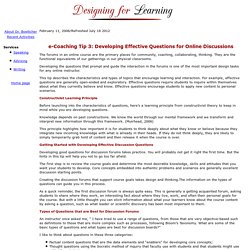

Educational Leadership:Instruction That Sticks:Strategies That Make Learning Last. Daniel T.

Willingham The second way is by illuminating fundamental principles of how students think and learn. Every teacher has a theory of how children learn; the theory may be unstated, but every teacher takes actions (or refrains from taking them) in the belief that doing so will help kids learn better. If researchers could offer principles of memory that are relatively universal across students, materials, and contexts, now that would help educators.
The fact is, we want students to learn efficiently when we ask them to study on their own. 3 Ways Colleges Are Adapting to Online Learning. From putting lectures online to offering math homework in 3-D and creating massive open online courses accessible to anyone for free, colleges and universities are marshaling new technology and the Internet to educate students in novel ways.

Anyone headed to campus these days should get set for "a blended experience," says David Leebron, president of Rice University and an advocate of online learning. While some college students will probably still have an entirely brick-and-mortar experience, Leebron says, other folks "may get their education entirely online. " Featured Mobile App Series - Back to School. About good practices and sound policies that accelerate the effective adoption and use of technologies in teaching and learning.

The mobile landscape is constantly evolving. WCET App-ologist, Robbie Melton, associate vice chancellor with the Tennessee Board of Regents, share her top apps for higher education via the featured mobile app series. Each of the lists below contains apps within a category that is useful for those in higher education. CTE - Instructional Designer, College Reading/ESL Instructor. This was a really wonderful event once again – I can’t recommend this conference highly enough.

This was the first year I started to feel a sense of community here which was nice – recognizing old friends – Leslie Felbain who came to our campus last year to present Teaching as Performance – and the folks who did the lightening round tech demos. Barb Eshbach and I presented the ELLI project that we did with Jorge in the fall and had a few folks really interested – from CUNY. Serendipity…..a presenter from U. of Bristol was there who actually works with Ruth Deakin Crick and knows ELLI- Dr. Phil Langton – talking about GRIT as a predictor of student success. So what can I share from what I learned? 1) For those thinking of publishing in SoTL – a new open access journal at SUNY Plattsburgh called The Common Good. They just sent out a call for papers for a special issue on Using Popular Culture in the Classroom – deadline January 1, 2015 – contact Jessamyn Neuhaus at neuhauj@plattsburgh.edu.
Student Persistence in Online Courses: Understanding the Key Factors. March 27, 2013 By: Maryellen Weimer, PhD in Teaching Professor Blog.

12 Powerful New Ideas For 21st Century Learning. How we learn is changing in response to a changing environment, from fluid digital environments to constant access to information, incredible peer networks to learning simulations, 21st century learning is teeming with possible learning pathways.

So it seemed appropriate to take a look at a handful of these new approaches–not so much formal learning approaches such as project-based learning or mobile learning, but rather some of the platforms and tools themselves. The immediate benefit is to take inventory in what’s available now. But picture, we can kind of trace a line through these emerging approaches to get an idea of where learning is headed, and what we might expect in the next 3-5 years as the blistering pace of changes continue–and how the “crowd” will be a part of it all. 1. Google Search Summary A search engine to help you find the information you’re looking for. What Makes It Special. Free Sticky Notes Tools for Teachers and Students. 50 Interesting things you can do in your online courses « Rose Colored Glasses.
Almost any activity can be designed to be carried out in some way or another for an online course.

Most important is that the instructor must set up the activity with all the supporting and explanatory documentation necessary for the students to understand fully what they are to do, when, where in the course they are to do it, what is expected specifically, and how they will be evaluated. Areas in the course must be designed and set up in advance by the instructor to account for and accommodate, explain, model, and evaluate each activity. Below are some ideas to get you thinking about what is possible and how. Skepticism About Tenure, MOOCs and the Presidency: A Survey of Provosts. Today's provosts are a skeptical lot.

That may come with the territory, as they must constantly prioritize some ideas (and some people's careers) over others -- tasks that are never easy and have been made more challenging by the economic downturn. But the 2013 Inside Higher Ed Survey of College and University Chief Academic Officers finds evidence that in some areas of higher education (MOOCs or massive open online courses, for example) provosts aren't yet ready to jump on the bandwagon, and relatively few see these offerings playing a positive, transformational role in higher education. What I'm learning from Harvard: A MOOC story. Taking a bit of my own advice, I recently started working through a computer programming MOOC from Harvard, with the goal of distilling out teaching tips and online course ideas from a student’s perspective.
While learning some useful job skills, I will share my experience to help designers of MOOCs and traditional online classes think about best practices in their course design. The on-campus introductory programming course, called CS50, is one of Harvard’s most popular electives, with over 600 students enrolled this semester. The vast majority of them are not computer science majors. Their first attempt at a CS50 MOOC this fall had over 50,000 online enrollees in September, a month before the course started. The on-campus lectures and small-group sessions are recorded and posted online for the MOOC students, who will use these to perform the same assignments through the same software, and the same learning platform as the "real" students. See Our Open + Free Courses. MiraCosta MOOC Flex session. Smgroups.pdf (application/pdf Object)
Untitled. February 11, 2006/Refreshed July 18 2012 e-Coaching Tip 3: Developing Effective Questions for Online Discussions.

50 Best eLearning Posts Of 2012. Who is training the online teachers to teach online? January 9, 2013 by davidgrebow13 NEWSFLASH: Online Education is Here to Stay.

Okay so tell me something I don’t know. When I start to see articles and stories appearing in the NY Times, NPR, WSJ, on TV and lots of other places I start to think “mainstream”. What every one of you reading this already knows has become The Latest Big News. Best, Worst Learning Tips: Flash Cards Are Good, Highlighting Is Bad.